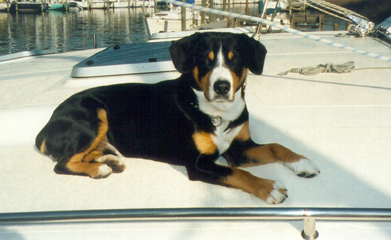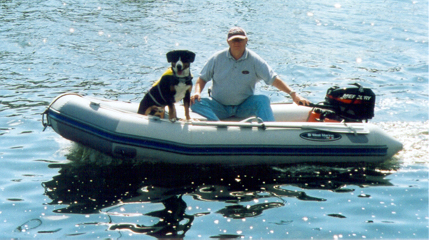
Toby on Sunspot Baby

Toby on Sunspot Baby
A SERIOUS LOOK AT TAKING A DOG ON THAT FIRST CRUISE
We donít think of ourselves as dog people, but life doesnít seem complete without that four legged member of the family. A dog has always been part of our cruising plan and after years of dreaming and preparation, we finally took that first long cruise aboard Sunspot Baby, our 38í Prout catamaran. Departing in February and returning June, 2004 we cruised from New Bern, NC to the central Exumas and returned. Toby, our four year old Entlebucher went with us. Knowing how to sail does not mean you know how to cruise. Neophytes afloat we learned a lot about ourselves, our boat, and our relationship with Toby. This article summarizes our pet related experiences and offers advice to other new cruisers.
Toby was not deck trained. There was no doubt in our mind that he would figure it out and we expected a few bad choices on his part. There didnít seem to be any rush because we planned to go down the ICW, anchoring each night and Toby could go ashore morning and evening. He functions pretty well on two sessions a day. Boy, were we naÔve. Suitable anchorages on the ICW are fewer than we expected, and fewer still are good for landing a dog. Each day we combed the cruising guides to find an anchorage with good shore access and spent many nights in marinas simply so we could manage dog duty.
The first time Toby missed a shore visit was on our passage from Bimini to New Providence. The second night, He could hold it no longer and we awoke to the sound of running water in the cabin. Well, we expected some bad choices at first. Through the remainder of the cruise he would, when desperate, whiz on deck but never rewarded us with #2. We continued to take him ashore as often as reasonable and twice most days when we were near shore.
Size is relative and after owning two Rottweilers, Toby seemed small to us but he comes in at 55 to 60 lbs. He is athletic and eagerly leaps into and from the dinghy with ease. Some fixed docks at high or low tide were more difficult and we sometimes wished he was of a size that could be handed or carried across easily. Believe me; we got over thinking of him as a small dog.
Intact male dogs, including Toby, are sometimes aggressive toward each other. We never had a real problem but were always careful when meeting other dogs. Many islands had free roaming dogs that came to check him out.
With a short, flat coat, Toby doesnít look like a dog that would shed much but looks are deceiving. Everyday we cleaned up dog hair. Our shower discharge became clogged with dog hair and he was seldom in the head.
Despite our best efforts including sea water sluices with a fresh water rinse, he always brought sand aboard after a trip to the beach. He then distributed it liberally in the cabin and our berth. Small vacuums lack power and it is a big job to vacuum up hair and sand in the cabin. We think we maintained our sense of humor, laughed about changing our names to Harry and Sandy, and joked that our cockpit had shag carpeting.
We didnít joke about the possibility of a dog overboard situation. While making crossings Toby wore a float jacket with a water activated strobe. He was allowed to go without float gear when we made short hops or were at anchor. At one anchorage we missed him and found him swimming near the sugar scoop. He probably jumped to the dinghy and missed. He loves the dink and bounds in given any opportunity.
After that episode, we rigged a tether attached to his harness allowing him access to the cockpit and surrounding deck but too short for a trip overboard. He figured it out quickly and only occasionally got the tether tangled in the winches. It was, however, an excellent trip point for the two legged crew. The harness provides a handle to pull him aboard. It sometimes snagged on the life line as he went to or from a dock, but if he missed a leap he was easy to retrieve.
 Entlebuchers are
not couch potatoes. They love and require exercise. I donít mean a walk around
the block on a leash. They want to run. If Toby doesnít get a chance to let it
out he goes into what we call Ya Ya Overload. Unless he gets that endorphin fix
he is bouncing off the bulkheads and pesters us endlessly letting us know he
needs to play. Even if he had been completely deck trained, we had to exercise
him and found no good on board option.
Entlebuchers are
not couch potatoes. They love and require exercise. I donít mean a walk around
the block on a leash. They want to run. If Toby doesnít get a chance to let it
out he goes into what we call Ya Ya Overload. Unless he gets that endorphin fix
he is bouncing off the bulkheads and pesters us endlessly letting us know he
needs to play. Even if he had been completely deck trained, we had to exercise
him and found no good on board option.
We took enough food for Toby as part of our provisions. Filling valuable stowage space with bags of dog food could be a problem on some boats. Our fall back plan if we ran out of food was rice boiled with a little meat.
Toby is a good watch dog and takes his job as head of security seriously. He has a big bark and an imposing physique. Behind his bluster he is overly friendly and is much more likely to knock you down licking you than to bite. We wished sometimes he wouldnít announce his position of authority to every one who stopped by the boat, but his presence was a positive deterrent to unwanted visitors.
Toby impacted every facet of cruising. He even affected our float plan in the Bahamas. We didnít think he would mix well with iguanas or free roaming pigs so we skipped a couple of islands.
We have both the boat and dog activities pretty well in hand now. We will continue to learn on every voyage, but the curve shouldnít be as steep. Toby is a good crew member and will go on our next cruise, but on balance, we would have been wiser to leave him at home the first season. We were learning to handle a lot of new situations. Stress and exertion were not uncommon. Some days were downright trying and after a hard day on the water a dinghy ride to shore with a dog on ya ya overload was not something to anticipate, especially in a marsh with nothing but muddy banks in view or in choppy waters and big wind.
In summary, we pass along these opinions. Leave the dog at home the first year. You will have enough on your plate. After the boat drill is second nature, you can better deal with the four legged crew. Of course, if someone told us that before we left, we would have disregarded it. We are attached to Toby didnít even consider leaving him behind. I, therefore, offer these other bits of advice.
When choosing a dog, consider some desirable attributes. A small dog is easier to land and requires less food to stow. All dogs need exercise but a dog that doesnít require a lot is good. A miniature breed might get enough exercise fetching a toy in the cabin.
A female or neutered male may get along better with new dogs they meet.
A non-shedding breed or mix would be a blessing. Poodles, Schnauzers, and Portuguese Waterdogs are breeds that come to mind but there are others.
Check with your Vet. Make sure the dog is healthy enough to travel. If you go to a country like the Bahamas you must have a health certificate anyway. Get your vet to make up a dog first aid kit for you. Our vet was very helpful stocking the kit and also advised us on dog sized doses of human medicines. Hopefully you wonít need it, but be ready. You may be days away from a veterinarian
Dogs get sea sick too. For years we have given Tums to dogs susceptible to motion sickness. Given before the crossing they work well and the dog is not as drowsy as if given a small dose of Dramamine. Wrapped in a piece of cheese, Toby wolfs down chewable Tums.
Whether you get a new dog or are taking old reliable Rover, deck train them before you go. We met cruisers with a little box of sod. We tried the fake grass mat without success but others have made it work. We tried the scents that are supposed to signal a dog to go there, but Toby thinks they stink and wonít go near them. We met a couple who had a stinky shrimp net their dog used. No amount of pleading would entice them to sell me half of it. Whatever you try, stay with it until you find something that works and teach the dog to go on deck. Take them on the boat and stay afloat until they learn. As long as you take them ashore at all, they will try to wait you out. At least Toby did.
In the ICW, anchorages near a public launch ramp give an easy place to go ashore. Charts of the ICW show the location of most of these. Cruising guides often did not include the fact that an anchorage is near a ramp.
If your dog will be in the water, rig a ramp or some other method that the dog can use to get on the boat. Train the dog to use it. Leave the device down while at anchor so that if the dog falls in, it can self rescue.
Rig a tether to keep your dog from going overboard accidentally. Get a dog life jacket that fits and use it when appropriate. If the jacket is off, a harness is a better handle than a collar. Remember you could be retrieving your retriever with a boat hook.
The one aspect of our first cruise that was not pretty much what we expected was dealing with our dog. Cruising is wonderful; dogs are great. They go well together but we suggest you break the learning curve into bite size chunks.
On our fifth cruise Toby finally started using the deck for bowel movements without apparent anxiety. Of course he is now nine years old and maybe just can't hold it as long, but we feel less guilty when we have days when going ashore is not convenient or even possible.
Toby was our shipmate for 14 wonderful years. In March of 2014 and in obvious decline he had a serious seizure and we decided it was time to release him from his infirmity. We miss him still. Will Rogers said "If dogs don't go to heaven, then when I die I want to go where they do." He made seven extended cruises to the Bahamas and up and down the East Coast from the Chesapeake to Biscayne Bay.
George Stateham